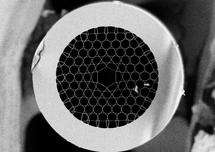Memory closes in on single photons

(Phys.org) —In a world-first, an optical memory – a key component for quantum computers – has been created within a hollow-core optical fibre and shown to operate at the level of a single particle of light (a photon).
Single photons of light are the basic building blocks for quantum-enhanced computers and sensors. Unfortunately, creating exactly one photon is exceptionally challenging; most sources of single photons succeed in working only rarely and at random intervals. As a result, creating many single photons at the same instant becomes extremely unlikely, which is a major drawback for anyone hoping to use single photons to perform calculations. In theory, an optical memory could store single photons generated by individual sources, in effect briefly 'caching' them, so that many synchronised single photons could be produced at once. Such synchronised photons could be used to perform calculations many times faster than conventional computers.
Now an international team led by scientists at Oxford University has demonstrated in a new experiment that light pulses can be stored and retrieved using caesium atoms confined in the centre of a specially designed hollow-core optical fibre at room temperature. A report of the research is published in Nature Photonics.
'Unlike the standard fibre made with a glass core that might be buried under your street to carry your home broadband, these fibres can guide light in an empty core that can then be loaded with atoms to enhance their interaction with optical pulses,' said Michael Sprague of Oxford University's Department of Physics, lead author of the report.
'As the light and atoms are confined to a small area inside the fibre, the amount of energy needed to operate the memory is reduced by a factor of 200. We showed that we could store light with a noise level that was much less than that of a single photon, which points to the memory's promise for storing pulses of light with interesting quantum properties,' he adds.
While caesium-based fibres are not compatible with the standard optical fibres used in telecommunications, it would be feasible to splice a hollow fibre optical memory into a conventional optical network. At the moment, the duration of the experimental optical memory is 30 nanoseconds, but the team believes it should be possible to increase this to 100 nanoseconds; not very long for some applications but long enough to create synchronised groups of single photons.
'So far nobody has managed to achieve the milestone of storing a true single photon in a room-temperature memory, but our work shows that memories that can get tens of synchronised single photons working together may only be a few years away,' said Michael Sprague.
Journal information: Nature Photonics
Provided by Oxford University




















